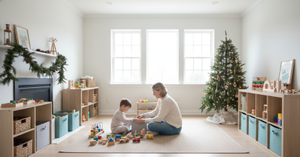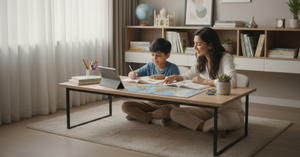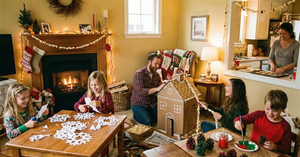Your child's bedroom is more than just a space for sleeping - it's a crucial environment that can greatly impact sleep quality, emotional well-being, and overall development. From infancy through teenage years, the design and layout of a bedroom play a key role in promoting restful, healing sleep. This blog will guide parents through the key elements of bedroom design, focusing on how to create an environment conducive to sleep for children from infancy through adolescence.
The Importance of Bedroom Design for Sleep
Your child's bedroom is a sanctuary for rest and relaxation. A thoughtfully designed space can help them feel safe and calm, making it easier to fall and stay asleep.
Key Elements of Bedroom Design
- Color Scheme: The colors in a child's bedroom can significantly affect their mood and ability to relax. Soft, warm colors like light blues, greens, and pastels are known to create a calming atmosphere. Avoid bright or overly stimulating colors that may energize rather than soothe.
- Lighting: Proper lighting is essential in setting the mood for sleep. Natural light during the day regulates circadian rhythms, while dim lighting in the evening signals to the body that it’s time to wind down. Consider having blackout curtains to block out external light sources at night. Additionally, bedside lamps with warm-colored bulbs can provide gentle illumination for reading without being too harsh.
- Furniture Placement: The layout of furniture can greatly impact how a child interacts with their space. The bed should ideally be positioned away from the door but still allow the child to see the entrance without feeling exposed. This arrangement creates a sense of security while promoting restful sleep. Ensure there is enough space around the bed for easy movement, especially during nighttime trips to the bathroom.
- Bedding and Mattress: A comfortable mattress is essential for good sleep quality. Choose a mattress that suits your child's sleeping position and preferences—whether they prefer firm or soft support. High-quality bedding made from breathable materials can help regulate body temperature throughout the night, contributing to better sleep.
- Decluttering: A cluttered bedroom can lead to feelings of anxiety and restlessness. Teach children to keep their rooms tidy by providing storage solutions such as bins or shelves that are easily accessible. A clean and organized space encourages relaxation and makes it easier for children to unwind at bedtime.
Age-Specific Considerations
Infants (0-12 Months)
For infants, safety is foremost in bedroom design. Cribs should meet safety standards and be placed away from windows or heavy furniture. Soft colors and gentle lighting can create a soothing environment conducive to sleep.
Tips for Parents:
- Use white noise machines or soft lullabies to help mask disruptive sounds.
- Keep the room at a habitable temperature (68-72°F) to prevent overheating.
Toddlers (1-3 Years)
Toddlers benefit from a playful yet calming environment. Consider incorporating soft rugs for playtime that can also serve as comfortable surfaces during bedtime routines.
Tips for Parents:
- Have a consistent bedtime routine that includes dimming lights and reading stories.
- Use nightlights with soft glows to provide comfort without disrupting melatonin production.
Preschoolers (3-5 Years)
Preschoolers are developing their imaginations, so adding personal touches like wall art or themed bedding can make their space feel special while still being calming.
Tips for Parents:
- Encourage independence by allowing them to choose some decor items.
- Keep toys organized but accessible to promote play without cluttering the sleeping area.
School-Age Children (6-13 Years)
As children grow older, their bedrooms often become multifunctional spaces for studying and relaxation. Include desks or study areas in the design while ensuring they don’t detract from the sleeping area.
Tips for Parents:
- Use dividers or furniture placement to create distinct areas within the room.
- Encourage regular cleaning habits by making organization easy with designated storage spaces.
Teenagers (14-17 Years)
Teenagers value privacy and personal expression in their spaces. Allow them some autonomy in decorating while ensuring that their room remains conducive to sleep.
Tips for Parents:
- Encourage them to keep screens out of the bedroom or limit usage before bedtime.
- Provide options for ambient lighting that they can control based on their preferences.
Additional Design Tips
- Incorporate Nature: Adding plants or nature-inspired decor can enhance relaxation and improve air quality in the bedroom. Plants like lavender or snake plants are known for their calming effects.
- Sound Control: If your child is sensitive to noise, consider soundproofing options such as rugs or acoustic panels on walls. White noise machines can also assist in drowning out disruptive sounds from outside.
- Temperature Regulation: Ensure proper ventilation and consider using fans or air conditioning units during warmer months to maintain a comfortable sleeping temperature.
- Personal Touches: Allowing children to personalize their space with photos or artwork fosters a sense of ownership and comfort in their environment.
Conclusion
Creating the perfect sleep environment is a dynamic, ongoing process. Each child is unique, and their bedroom should reflect their individual needs while supporting healthy sleep patterns. By understanding the principles of effective bedroom design, you can build spaces that promote restful sleep, emotional security, and overall well-being.
Remember, the best bedroom design is one that makes your child feel safe, comfortable, and loved.









Be the first one to comment on this story.